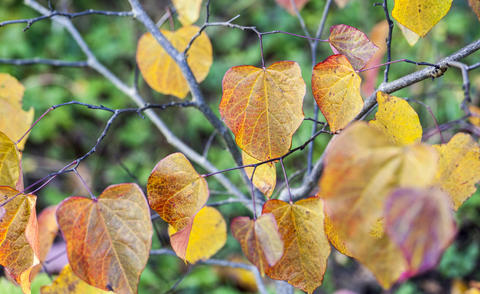Eastern redbud
With its magnificent pink bloom and deep red leaves, eastern redbud is one of the most uniquely beautiful garden shrubs. Here are some of our planting and care tips for Cercis canadensis ‘Forest Pansy’.
Factsheet
- Growth type
-
- large shrub
- Growth height (from)
- from 300 cm to 400 cm
- Growth width (from)
- from 200 cm to 400 cm
- Growth characteristics
-
- upright
- Flower color
-
- pink
- Flowering time (month)
-
- April to May
- Flower shape
-
- Cluster
- Leaf color
-
- red
- page format
-
- heart-shaped
- Sheet properties
-
- Autumn coloring
- Fruit color
-
- brown
- Fruit shape
-
- Sleeve
- Light
-
- sunny to semi-shade
- Soil type
-
- loamy
- Soil Moisture
-
- fresh
- humid
- ph value
-
- alkaline to weakly alkaline
- Lime compatibility
-
- lime-loving
- Nutrient requirements
-
- nutrient-rich
- Decorative or utility value
-
- Flower Decoration
- Leaf ornaments
- Climate zones according to USDA
-
- 6
- Use
-
- Single position
- Landscape woody plants
- Garden style
-
- Japanese Garden
- natural garden
- Pot garden
- Bee Friendly
- bee friendly plant
The eastern redbud (Cercis canadensis) is one of eleven species in the genus Cercis (redbud) and is therefore related to the Chinese redbud (Cercis chinensis). They belong to the family Caesalpinioideae. The wild form originates from North America, but in this country, you’ll only find the cultivar Cercis canadensis ‘Forest Pansy’. This is significantly smaller than the wild form and has more ornamental value in the garden.
Cercis canadensis ‘Forest Pansy’ has shrubby, upright growth with multiple trunks, reaching heights of up to 13 foot, or more rarely, 26 foot. Over the years, the wide-spreading shrub can grow as broad as it is tall. The gray furrowed bark peels away in patches on older trees. The eastern redbud becomes very winter-hardy with age.
The eastern redbud is deciduous and attracts plenty of attention in the garden thanks to its dark red, cordate leaves - a typical characteristic of redbuds. Following blood-red new growth in spring, the leaves of this variety get darker and darker throughout the year. The leaves become a little lighter again with mesmerizing yellow-red tones, in fall.

In April and May, and in mild conditions sometimes even in March, the eastern redbud impresses with an abundance of flowers before the leaves sprout. The butterfly-like blossoms - typical of the family Caesalpinioideae - are dark pink and appear in dense clusters on branches and on the trunk itself.
Eastern redbuds produce brown legumes. The ornamental plant develops round, flat seeds in approximately 2.36 inch long pods, which often remain on the tree throughout winter.
Cercis canadensis ‘Forest Pansy’ do best in sunny to partially shaded spots that are sheltered from the wind. When the eastern redbud is kept in full or partial shade, the leaves turn green.
The eastern redbud is best suited to nutrient-rich, fresh to moist, loamy soils with a high lime content. The roots grow quite deep and do poorly in waterlogged soils.
Cercis canadensis ‘Forest Pansy’ is best planted in spring, as the shrub is quite sensitive to frost when young. This way the plant can successfully establish roots by winter.
Young eastern redbuds should be given a little compost in spring. Older plants do not need any fertilizer, as Caesalpinioideae species are able to fixate nitrogen and supply themselves. Newly planted young trees should be given winter protection in the form of brushwood or in the first few years.
Cercis canadensis ‘Forest Pansy’ has a natural, shrubby growth habit and, aside from the occasional thinning out in fall or winter, does not need pruning. The plant can also be grown as a standard tree. It then develops attractive branches that curve downwards. The older the shrub, the more flowers it produces without aging too fast. But the eastern redbud generally tolerates pruning well. Neglected shrubs can be hard pruned in spring before flowering. Caution: The eastern redbud flowers on mature wood! Pruning therefore has an impact on the number of flowers in the following year.

Thanks to its abundant blossoms in spring, its wonderful red leaves in summer and, last but not least, its decorative pods in winter, the eastern redbud is a real eye-catcher in the garden all year round. It should ideally stand alone in a suitable spot, so that it can spread optimally. With sufficient space and sun, the eastern redbud provides a wonderful backdrop for flower beds. Cercis canadensis ‘Forest Pansy’ is at its best in a Japanese garden or in front of a dark green hedge. As a young plant, the eastern redbud can also be grown in pots, but should be planted in the garden after a few years.
As Cercis canadensis ‘Forest Pansy’ is a cultivar, it can only be propagated by grafting. This is generally not feasible for hobby gardeners.
Eastern redbuds are very rarely affected by diseases and pests. The shrub is not known to suffer any serious problems.

